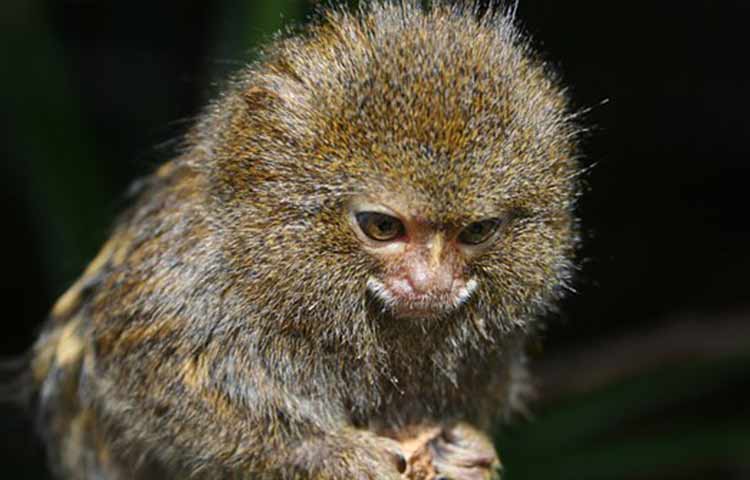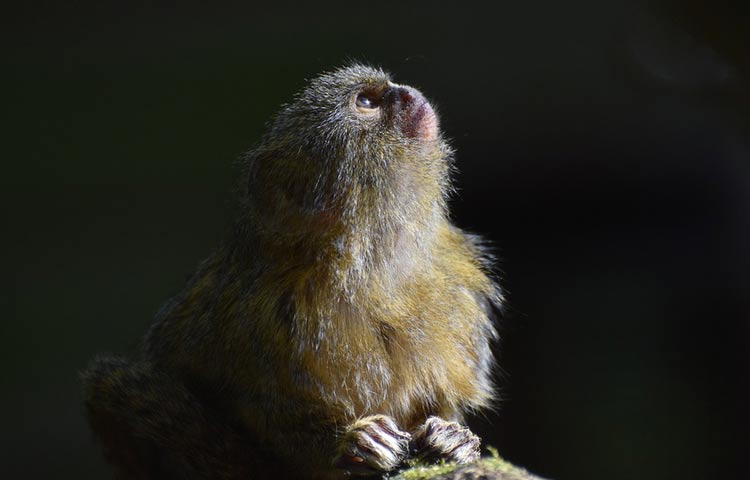Scientifically known as Cebuella pygmaea, the finger monkey is a domesticated species of monkeys native to South America. Also referred to as the pocket monkey, it’s distinctively known for its wee size measuring only four to six inches long and weighing approximately 3.5 ounces. More so, it can comfortably rest off an adult finger.
As tiny as it may be, owning a pygmy marmoset as a pet can be a huge responsibility, not to mention the huge chunk of cash you’ll require to maintain it. There are many things you need to know about them, including their characteristics, diet, living conditions, and how to care for them.
Much more information in the preceding sections below.
What is a Finger Monkey?
A finger monkey also referred to as pygmy marmoset is a domesticated species of monkeys belonging to the Callitrichidae family. From this new world monkey group consisting of marmosets, tamarins, and lion tamarins; the finger monkey is the smallest known primate weighing about 100 grams for adults.
The finger monkey is indigenous to South America, precisely the rainforest of the Amazon Basin. Living in the world, the Callitrichidae family is now arboreal; adapted to wildlife, and especially the trees.
They are gumivores feeding on the sap and gum from evergreen riparian forest trees close to the river. However, that’s not all they feed on as you will learn shortly.
Baby Finger Monkey Size
A newborn pygmy marmoset measures five inches tall with a weight of only 15 grams. They are very delicate at this time seeing as they are in the most vulnerable stage in their life cycle.

Within the first two weeks to a month, the baby marmoset is completely dependent on its parents.
The mothers tend to nurse the babies as fathers carry them on their backs. This is very risky as their mortality is threatened with the possibility of the baby falling from their fathers back.
However, after two you three months, weaning begins and the baby’s life is no longer under threat.
More photos of cute baby marmosets


Fully Grown Finger Monkey
An adult pocket monkey is over 12 cm tall and over 100 grams in weight. The tail extends to approximately 20 cm long.

Mature males will weigh more, an average of 140 grams against 120 grams in females. This takes them over 50 more days to fully mature into adulthood.
Pygmy Marmoset Fur Texture and Color
Similar to any other primate, their body is covered with fur to keep them warm. Their fur is very bristly and bushy, and it stands out from their head a bit like a lion’s mane.

They also have unusual colors streaked across their chests and backs. While their primary colors are brown, black, beige and gray, there are often yellow or white splotches that dot them in distinct and unique shapes. The underparts are lighter with shades of yellow, orange, or tan.
The tail has spherical rings black in hue. In some cases, the face has specks of white around the cheeks with a white vertical line in the midst of the eyes.
Can I Have a Finger Monkey as a Pet?
Monkeys are primarily primates meaning they are able to communicate and cohabitate with human beings. However, certain traits may question their suitability as to whether they’ll be good pets. Let’s debate!
Why They are Good
- Peaceful, fun, and loving temperament. They love to play and cuddle.
- Quite easy to maintain once you get the hang of it.
- Not tiresome to carry around.
Why They May Not Be Good
- They are costly – besides the purchase amount of about $1500 to $4000 you spend, you have to invest in food, living conditions, medical and health matters, plus other requirements.
- It’s illegal to ship them into certain states. If you fall under these states, it’s not worth the hustle.
- They can be very clingy – especially to your finger.
- Primates are unpredictable, have a sense of independence (especially for adults), and could be carriers of unknown diseases.
Diet (Baby & Adults)
As you’ve read from above, pygmy marmosets are primarily gumivores that feed on gum, sap, and other exudates such as latex from evergreen riparian forest trees. This is what they’re naturally and scientifically bred to do, but that’s the case for those that live in the wild.

Pet marmosets have a somewhat better diet. Newborn pygmies will use infant formula for the first two weeks preceding the second month they when the weaning begins.
They also feed on insects, especially butterflies, which would be attracted to the sap from the tree.
In addition, they would feed on arthropods, plant parts, several other insects, and tiny reptiles.
While in captivity, you can give them insects such as mealworms, waxworms, grasshoppers, and crickets. You can also get store-bought kibble; its a combination of crushed and dried insects.
As the exudates from the trees are not highly sourced with proteins, carbohydrates, and calcium; a supplementary diet is required.
The diet could include boiled eggs, lots of different proteins like chicken, fish, turkey, grains, cereals, plenty of fruits, and vegetables. In terms of hydration, water is very essential. You can also include milk from a goat, fresh fruit juice, and sap.
Habits (Baby & Adults)
Finger monkeys are free-spirited; therefore, they enjoy active sports when they aren’t feeding. They are also very clingy to its owner, especially if you own another pet. Adult pocket monkeys can often be aggressive when they don’t get what they want or when hungry. Despite that, they are very calm and self-absorbent.
Adult finger monkeys love to associate in groups, that could be from two to nine individuals; one or two adult males and one or two adult females.
They appreciate a sense of belonging, which is why they would feel threatened if a poacher was to abduct their kind. However, as rare and exotic they are, they’re equally threatened by nature’s predators.
The female species has a unique gene that allows them to mate and give birth to twins or triplets even twice a year.
As habit indicates once they are fully matured, they need to mate and reproduce to ensure the continuous cycle of life. Mating season occurs within the months of May and June and November through January.
To instill independence in their children, the parents will leave their two weeks old baby in a secluded and protected place and heads out to forage in the trees. This way the baby begins to relieve their burden of dependence on their parents.
Last but not least, as the marmosets grow older, they become more and more unpredictable – even with previous training. They lack patience and get bored easily hence, they need to engage more often.
Do They Bite?
Yes, finger monkeys can bite using their sharp teeth in times when they feel threatened or hungry. Their passive aggression causes them to attack using their teeth, scratch with their sharp claws, throw feces on their owners among other instincts.
Since they are seen as very tiny mammals, once vulnerable they tend to be very aggressive; sometimes too aggressive. As a mode of self-defense, they attack vigorously as females appear more aggressive and even less tolerant as they age.
How to Care for Them
As much investment as you put into owning this pet, they also carry a huge responsibility when it comes to caring for them. From providing the right living conditions to a suitable diet that supplements its normal gum; there are many factors to consider.
Habitat
As tiny as they are, finger monkeys need a considerably large cage. One that can offer adequate space for jumping, climbing, active sports, as well as other items. In a quest to maintain a wildlife feel, the cage needs to be installed with swings, artificial or real branches from trees, and some leaves.
Those will act as toys and aid the monkey not to get bored or lethargic. Ideally, the cage should be placed under direct sunlight or a heat source like a lamp, fireplace, or any other ultraviolet light sources.
Heat/ warmth is an essential requirement for these pygmies since they are very prone to getting common colds and chickenpox.
Lastly, the water supply. They also need plenty of access to water in their cages to keep them hydrated all day.
Diet
Incorporate plenty of fruits, snacks such as biscuits, Arabic gums, proteins, and carbohydrates in their diet. Other things you can include in the diet include;
- Cereals
- Pasta and quinoa
- Oats
- Arthropods like spiders and tiny crabs
- Miniature lizards
- Insects and flies
- Fresh leaves and other plant parts
Cleanliness
Finger monkeys exhume a very pungent smell, therefore, cleanliness is a mandatory requirement while taking care of the pet. Regardless of fitting it with diapers, a bathe here and it is necessary to avoid toxic scents emitting from the monkey or its habitat. Ensure to regularly clean their living space.
Health Issues
Being a primate, pocket monkeys can easily carry diseases from anywhere. They are also prone to getting sick with chickenpox, HIV, the flu among other conditions.
As so, it’s vital that the pet gets regular check-ups from a licensed veterinarian. Immediate medical care is needed in case you observe abnormal symptoms.
Fun Facts About Finger Monkeys
From the first look, it’s quite obvious that this is yet the smallest known monkeys in the world.

Their tiny size isn’t the only fascinating fact about them. Here are more fun facts about the pocket monkey.
- They have a sophisticated communication system comprising of three unique categories; chemical signaling, voice calls, and visual signs. The vocalizations are in three formations; trills and j-calls are used to signal locality, danger, or food over short and medium distances respectively. Long calls are travel distances and they’re used in the search for mates.
- The length of its tail is considerably longer than its body length. 6 – 9 inches over 4 – 6 inches.
- Baby pygmy marmosets are the wild’s “miss independents”. They are born with a certain amount of independence right off the bat. Unlike other species, they aren’t blind, hairless or helpless. They can see and move as soon as they get their bearings as a newborn.
- Scientifically, pygmy marmosets are much more “primitive” than some other monkey species. Because they lack opposable thumbs and prehensile tails. They’re also born with claws in place of nails.
- The 2017 Fingerling craze, that showcased colorful animal-shaped toys that could wrap around your finger was based on finger monkeys.
- The pocket monkey can rotate its head at 180 degrees.
- They can leap between branches over five-meter (16 feet) away.
- They have incredible survival tactics like piloerection, arching its back, and strutting in times of danger.
- They have specialized incisors that aid them to gouge in trees to feed on the gum.
More About Finger Monkeys






